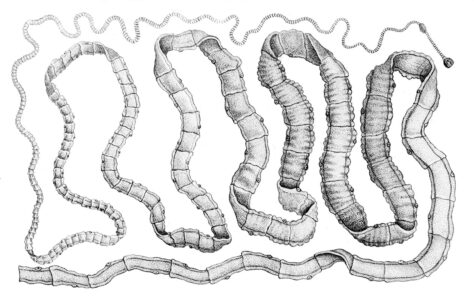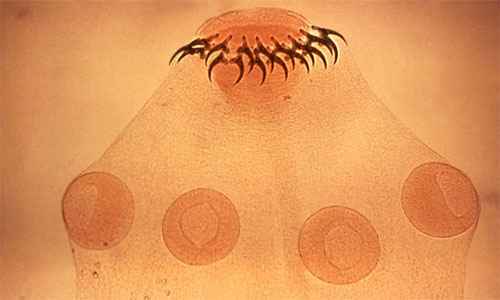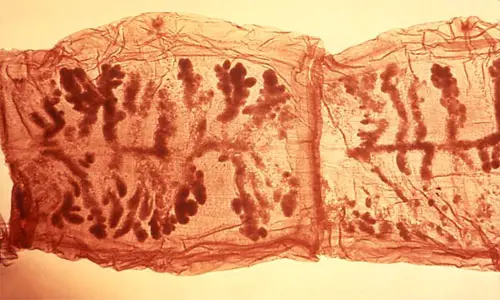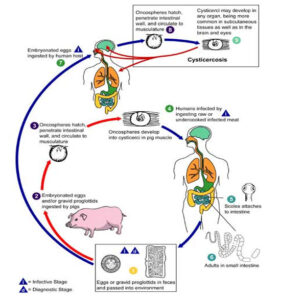Taenia solium is also called the pork tapeworm. It is the parasitic organism under phylum Platyhelminthes. It is found all over the world. It is the endoparasite and adult worm lives in small intestate of man who eat pork.
Systematic Position
- Phylum:Platyhelminthes
- Class: Cestoda
- Order: Cyclophyllidea
- Family: Taeniidae
- Genus: Taenia
- Species:Taenia solium
- Definitive Host: Human. Adult and larval forms are found.
- Intermediate Host: Pig and human.
Morphology of Taenia solium
Taenia solium has flat, ribbon-like body with white in color. It is triploblastic acoelomate and can grow up to 2 to 3 meters or more in length.

The scolex (head) is 1 mm, globular in shape that bears four citcular suckers and a rostellum with a double row of about 30 alternating large and small hooklets.

Neck is short and after it, the elongated body, known as strobila is present. The entire body is covered by tegument. The strobila is divided into proglottides or segments. These may be 800 to 900 in number (less than 1000). A gravid segment is about 12X6 mm, i.e. longer than broader.
The gravid proglottides contains lots of fertilized eggs which are spherical in shape with 35 to 42 µm in diameter.

Gravid Proglottid of T. solium: Image credit: wikimedia commons
The genital pores are situated marginally and alternate irregularly between right and left margins. The gravid uterus contains 5-10 lateral branches on each side of its main stem. This tapeworm can live up to 25 years.
Life Cycle of Taenia solium
Human is the only definitive host. It is found in man who take cyticercus cellulosae larvae containing undercooked pork.
The adult worms live in the intestine (upper part of jejunum) of man. The gravid proglottid can release 30000-50000 eggs in the host body. Eggs and segments are passed in the stools and contaminate vegetations and water. The eggs are swallowed by pig or human.

Life cycle of T. Solium: Image credit-wikimedia commons
The larvae liberate from the eggs in stomach, penetrate the intestinal mucosa and settle in different parts particularly muscles of pig or human. Here they develop into larva from cysticercus cellulosae. This may also occur due to autoinfection in individuals infected with adult worm.
The egg regurgitates from the intestine into the stomach where it hatches and the larva enters the blood circulation. The adult worm is formed in intestine of human from living larvae ingested with undercooked pork meat.
Pathogenesis and Clinical Features
Adult Worms
Adult worm infection is usually asymptomatic. The diseases are caused by the adult worm, known as taeniasis. If you untreated, the infections with Taenia solium last for about 2–3 years. In many cases, infected people do not show any symptoms up to one year.
The most common intestinal symptoms of taeniasis include:
- Abdominal pain;
- Nausea;
- Vomiting;
- Constipation;
- Diarrhea, etc.
Cysticercosis
Cysticercus cellulosae larvae are usually found in skeletal muscle and subcutaneous tissues. There may be serious effects due to presence of the larvae in vital organs like brain, eye, etc. The cysticercus may be calcified. Nodules found in subcutaneous tissue. In symptomatic cases, the following symptoms can be expressed:
- Headaches;
- Dizziness, and
- Seizures, etc.
If the brain is infected by the cysticercus larvae then it is known as neurocysticercosis. It is the leading cause of seizures worldwide. In heavy brain infection especially in children, the following symptoms are expressed:
- Encephalitis;
- Epilepsy;
- Personally change;
- Staggering gait;
- Signs of internal hydrocephalous;
- Eye blindness;
- Blood may show eosinophilia (20 t0 60% eosinophils).
Diagnosis
- Stool should be examined under microscope to detect eggs and proglottides.
- To detect cysticercus cellulosae, biopsy examination of a subcutaneous nodule should be done.
- X-ray examination may be helpful if the larva is calcified.
- Blood examination may show eosinophilia (20 to 60% eosinophils).
- Antibody detection should be done through fluorescent antibody test.
Prevention
- Under cooked pork should be avoided;
- Vegetables contaminated with feces should be avoided;
- Disposal of human feces should be done properly;
- High level of sanitation should be maintained;
- Fecal contaminated free pig feed should be insured to the pig;
- Pork should be cooked properly;
- Freezing the meat should be done at −10 °C for 5 days;
Treatment
- Praziquantel is used to treat for intestinal infection. In this case, 5 to 10 mg/kg praziquantel is used as single dose orally to eradicate adult worms.
- You can also use niclosamide as a single dose for adult. In this case, 4 tablets (500 mg each) are chewed or swallowed at a time. For children, the dose should be 5o mg/kg as a single dose.
- Corticosteroids, antiseizure drugs, and sometimes praziquantel or albendazole are effective for neurocysticercosis.
- In many cases, surgery may be needed to remove obstructive hydrocephalus or spinal or ocular cysticercosis.
Difference between Taenia solium and Taenia saginata
|
Characteristic Features |
Taenia saginata |
Taenia solium |
|---|---|---|
|
Occurrence |
Not rare |
Rare |
|
Definitive host |
Man |
Man |
|
Intermediate host |
Cattle |
Man and pig |
|
Body length |
5-10 meters |
2-3 meters |
|
Scolex |
Large, quadrate. No rostellum or hooks |
Small, globular with rostellum and hooks |
|
Neck |
Long |
Short |
|
Proglottides |
1000-2000 |
Less than 1000 |
|
Vagina |
Sphincter present |
Sphincter absent |
|
Ovaries |
Two, no accessory lobe |
Two with an accessory lobe |
|
Testes |
300 to 400 follicles |
150 to 200 follicles |
|
Genital pore |
Alternate and irregular |
Alternate and irregular |
|
Expulsion of segments |
Expelled singly |
Expelled in chains of 5 or 6 |
|
Egg |
Spherical in shape |
Spherical in shape |
